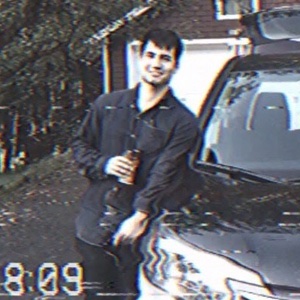‘Donnie Darko’ Explained: An Analysis of Richard Kelly’s Masterpiece
Looking to understand more about the dark, psychological horror film “Donnie Darko”? This article takes you through it all — plot, cast, symbology, and more.

Donnie Darko premiered at the Sundance Film Festival in January 2001, eight months before the September 11 terrorist attacks. It was the first feature-length film from director and writer James Richard Kelly. The film is considered one of the greatest cult classic movies of all time and was made with a budget of only $4.5 million. It was filmed in only 28 days, which coincidentally is about how many days transpire in the movie’s storyline.

Donnie Darko is a hybrid film and oscillates between horror flick and science-fiction masterpiece, with a bit of your typical 80s high-school movie and new-age religion thrown in. This complete analysis of the film will dive into the meaning of Donnie Darko: the characters, the plot, the story, the Easter eggs, the music, and everything else that makes the movie so special and weird. Obviously, it’s filled with spoilers. Without further ado, here is Donnie Darko explained…
Trailer
The official trailer for Donnie Darko is quite creepy. The trailer opens brightly, with an idyllic suburban environment in the America of the 1980s: green grass, trampolines, a pristine private school, and so on. The scene and music then rapidly transform to the darkness of a psychological thriller or scary movie. We are introduced to Donnie Darko, then the rest of the trailer oozes with unsettling scenes/suggestions of mental illness, hallucinations, violence, and sci-fi elements such as wormholes in time. All in all, the two-minute-plus trailer does a great job of articulating the movie’s feeling and plot without giving much away.
Characters

Despite the film’s meager budget, Donnie Darko features an all-star cast of famous names and recognizable faces. Drew Barrymore and her production house Flower Films were instrumental in making this all-star cast happen. The main characters are as follows:
- Jake Gyllenhaal plays the lead, Donnie Darko.
- Jake’s real-life sister Maggie plays Donnie’s sister, Elizabeth.
- Drew Barrymore plays Donnie’s English teacher, Karen Pomeroy.
- Noah Wyle plays another teacher of Donnie’s, Kenneth Monnitoff.
- Holmes Osborne plays Eddie Darko (Donnie’s dad), and Mary McDonnell plays Rose Darko (his mother).
- Katharine Ross is Donnie’s therapist, Dr. Lilian Thurman.
- Beth Grant plays Kitty Farmer, an annoying mom and gym teacher.
In terms of character analysis, Donnie Darko is the protagonist, and everything we know about the other characters filters through his narrative voice. What Donnie knows is what we know.

There is also the big question of who plays Frank, that guy in the bunny outfit/mask/costume. That’s James Duval, an actor that has played a variety of roles in independent films and big blockbusters. Patience Cleveland plays Roberta Sparrow or Grandma Death, another mysterious character. Jolene Purdy plays Cherita Chen, the young earmuff-wearing woman who’s constantly being bullied.
Other actors and actresses in the film include Jena Malone as Gretchen Ross (Donnie’s love interest), Patrick Swayze as Jim Cunningham (a motivational speaker reminiscent of Tony Robbins, whom Donnie hates), and even Seth Rogen — yes, you read that right, Seth Rogen is in Donnie Darko — and he plays Ricky Danforth, a bully at the high school.

“Ricky Danforth” is a great name for a high-school bully. In an interview, Rogen said about the experience of filming Donnie Darko: “It was a great experience; I didn’t get it back then, and still don’t, but had a good time.” Does the other bully on the left look familiar as well? That’s because it’s a young Alex Greenwald, the lead singer of the pop/rock band Phantom Planet, known most famously for their track “California,” which played at the opening sequence of the TV show The O.C. Alex Greenwald played coke-snorting bully Seth Devlin in the movie.
Plot
Donnie Darko takes place across four weeks in October 1988. You can divide the plot into three sequences: Donnie’s awakening, Donnie’s crimes and love, and Donnie’s sacrifice on Halloween night. In the awakening sequence, we are introduced to Donnie and his setting that is marked by a mysterious plane crash and late-80s suburbia. During the crime storyline, Donnie falls in love with Gretchen and commits three crimes: He floods the school, burns down a pedophile’s house, and shoots someone in the eye. Finally, the sacrifice plot is where the movie comes together, and we realize that everything that has been happening is due to a black hole in time that could destroy the whole world, and Donnie with the help of a six-foot bunny rabbit prepares to heal the tear in the universe with his sacrifice. The plot resolves via deus ex machina (god from the machine), where out of nowhere something happens that resolves the tension throughout the movie.
Analysis
Most people find the film Donnie Darko to be confusing. Even a casual viewer can enjoy the movie without understanding it, though. To interpret Donnie Darko, let’s start with the major symbols, motifs, and moments; then we’ll span out to a bigger-picture interpretive summary. We will answer what really happened in Donnie Darko? here, as much as it can be answered.
Bunny/Frank Costume
Who is Frank the Rabbit, that weird demented Easter bunny-like thing? Is he bad? Is he good? Where does he come from? Why does Frank wear “that stupid bunny suit,” as Donnie so elegantly puts it in the film?

Frank the Rabbit, or Franklin Anderson, Jr., is, as one commenter notes, a “reverse ghost” or the “manipulated dead.” He’s a reverse ghost because Frank is not dead in the real biological world of everyday existence. However, in Donnie’s alternative timeline, or parallel universe, or, most accurately, tangent universe, Frank is dead and was killed by Donnie and is only present via a wormhole. Donnie kills him because he runs over Donnie’s girlfriend accidentally while he’s on a run to get more beer.
Put simply, imagine there are two universes. In one universe, Frank is alive. In another universe, Frank is dead. Then the dead Frank of the other universe starts to break into the reality of the other universe to help change the trajectory of events so he doesn’t die, but also because by doing so he will save the world.
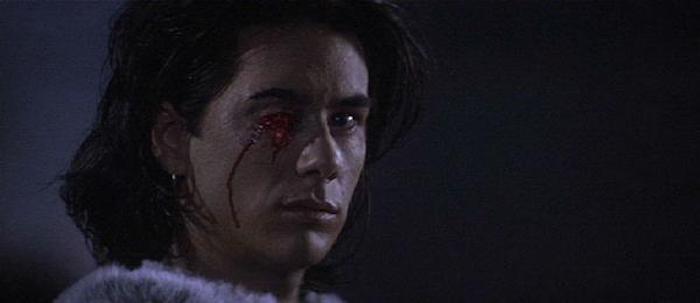
That’s also exactly what Frank does: He helps Donnie and the world, albeit in creepy and violent ways. The creepiness of Frank’s appearance and methods can be interrupted simply as a kind of distortion of him carrying himself over from one universe to the next. Just as how in our dreams things meld together or get distorted, so, too, does Frank.
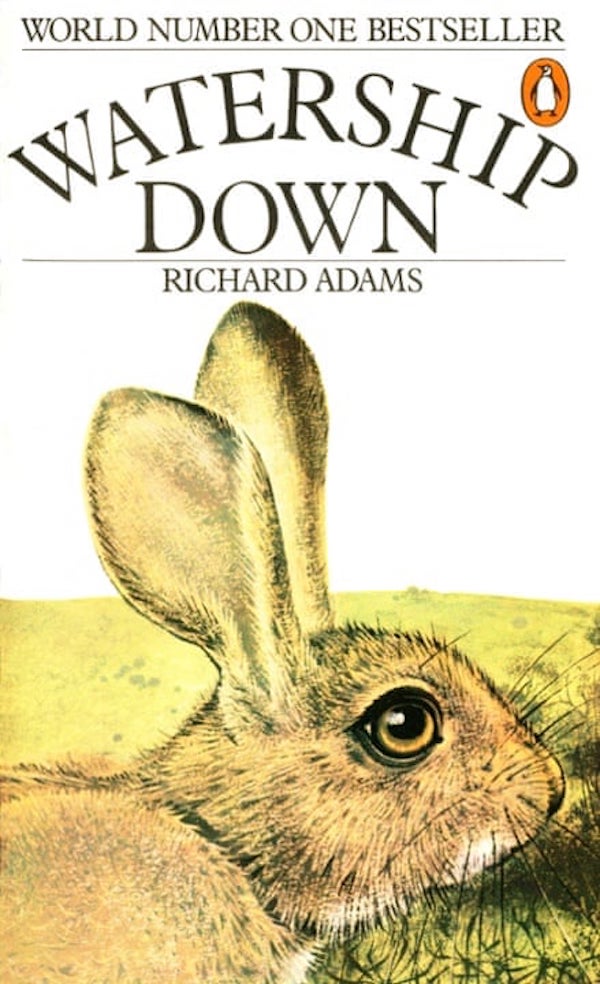
What about the famous bunny costume? This was likely inspired by the book Watership Down by English author Richard Adams, where bunnies talk and act like humans. You can explain that Frank ended up in the bunny costume somewhat randomly; Frank was likely being taught Watership Down in high school and somehow gripped onto the character as he moved through universes.
In essence, Frank is helping Donnie accomplish everything from flooding the school to burning down the mansion to figuring out how to save the world — and he’s Donnie’s saving grace. Frank is not the bad guy. He helps Donnie.
Donnie’s Tattoo: 28:06:42:12

What is the meaning of Donnie’s tattoo, or more accurately, what Donnie inscribed on his arm with a Sharpie? What is the role of numerology in the film? Frank explains the numbers to Donnie: “28 days…6 hours…42 minutes…12 seconds. That is when the world…will end.” The tattoo, then, is just a reminder to Donnie of how much time is left for him to, yes, save the world. It’s a countdown to the end.
On Stack Exchange, one user explains how the writer creatively employs numbers to create glitches in the Matrix-like effect throughout the film:
The movie takes place in 1988. Frank tells Donnie the world will end in 28 days, 06 hours, 42 minutes, and 12 seconds. If you add these numbers, the sum is 88. When Samantha asks when she can have kids, Donnie says: “Not until 8th grade.” Donnie mentions to his therapist that his dog Callie died when he was eight. (He is later seen holding a stuffed toy dog in her office.) Donnie jokes about the Back to the Future DeLorean, which had a speed of 88 MPH. According to the television reporter, the fire at Jim Cunningham’s house was extinguished “sometime after 8:00 last night.” The red-eye flight that almost crashes is Flight 2806, which boards at Gate 42 at 12 AM. The climax of Donnie Darko occurs one week before the 1988 US presidential election, when George Bush won on November 8, 1988 (11/08/88). The movie was shot (for a budget of less than US$5 million) in 28 days. There are 28 scenes in the director’s cut of this film.
The meaning of all these numbers creates a creepy occult undercurrent if you have enough time to pay attention to such things. The meaning of the number eight (8) in Donnie Darko does not seem to extend beyond simply being an interesting Easter egg in the movie.
Philosophy of Time Travel
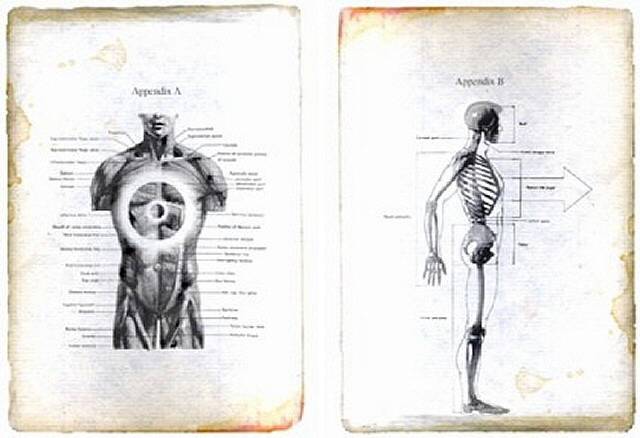
Theories of time travel are abundant in the film, which is what makes it so confusing and hard to understand. The best summary of such theories is in the Philosophy of Time Travel by Roberta Sparrow. This was written by director/writer Richard Kelly and released later as a book to help fans decipher the movie. This is the book that Dr. Kenneth Monnitoff (Donnie’s science teacher) gives to him, and it’s written by Roberta Sparrow/Grandma Death, the old woman who’s always checking her mailbox. It’s supposedly a work of fiction, but Donnie worries that it all may be true.
Spirituality/Religious Meaning
There is an interesting tension between science and religion, or between logic and mystery, in Donnie Darko. The tension is most clearly articulated in the biography of Roberta Sparrow (aka Grandma Death). The film tells us that Roberta Sparrow started out as a nun at a Lutheran church in Alexandria, VA but left the convent to become a science teacher at Donnie’s school in Middlesex, VA. Then eventually she lost her mind and “became a completely different person.” What does all this mean?

The allegory is clear. Roberta Sparrow represents both the occult and the scientific, both revelation and reason. Roberta had to study both religion and science to figure out and crack the secret of time and the universe — and once she cracked the code, she went insane, at least by the standards/norms of the primary universe or the everyday reality we all know and live in as we go about our biological lives.
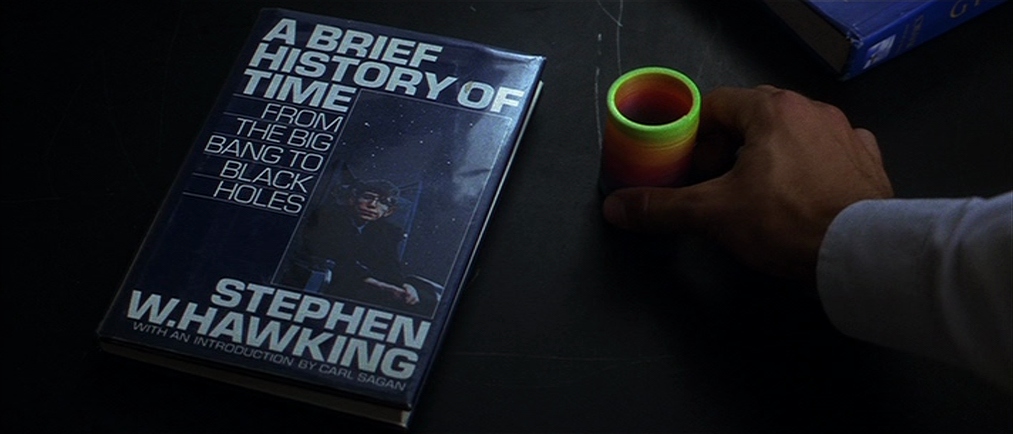
The evidence for the necessity of both science and religion is reinforced by the actions of science teacher Kenneth Monnitoff. When Donnie and his teacher are talking about the universe, they start by talking about Stephen Hawking’s A Brief History of Time. The conversation then evolves to when the science teacher gives Donnie Roberta Sparrow’s book, which is not a science book at all, but a religious book that begins with an invocation of prayer. It’s clear that both books are necessary for understanding the meaning of life, and because the conversation veers toward religion (or spirituality), Mr. Monnitoff has to stop the conversation with Donnie.

Donnie’s therapist, Lilian Thurman, describes Donnie as an agnostic. She says: “Donald, you are an agnostic. An agnostic is someone who believes that there can be no proof of the existence of God…but does not deny the possibility that God exists.” While this quote shows the importance of agnosticism in the film, Roberta Sparrow’s book, which plays an even more critical role in the Director’s Cut, also screams that the supernatural is at play.

Richard Kelly also establishes Donnie Darko as a Christ figure or even as a kind of antichrist against suburban notions of Christian sin. Donnie, like Jesus Christ, must sacrifice his own life to save the world. Additionally, it is explicitly signaled that we should draw such parallels when Donnie is in the theater watching a double feature of The Evil Dead (1981) and The Last Temptation of Christ (1988). That said, Kelly also draws parallels between Donnie Darko and superheroes in comic books; isn’t it funny how similar the name Donnie Darko is to Peter Parker?
They Made Me Do It/Fate
Predestination or predetermination is an important concept in Donnie Darko. In this part of the article, the analysis will get theoretical and extrapolative, as the question of is there free will? is only vaguely answered. Let’s start with what is explicit and work toward what is implicit, and then what is purely educated theory.

After Donnie floods the school, he writes out They made me do it in a weird font that is supposedly Donnie’s handwriting. The idea is that whatever Donnie is doing is out of his control. Donnie tells his therapist: “I have to obey him…because he saved my life. He controls me, and I have to obey him or I’ll be left all alone.” The point here is crystal-clear: Donnie’s body and mind are at the service of something beyond himself, and his free will is greatly compromised. One gets the sense that if he doesn’t obey this force, he will be sucked up into some time vortex alone. (Or to use the film’s obtuse language, Donnie is the “Living Receiver” at the mercy of the “Manipulated Dead” operating from another dimension.)
Donnie’s free will is compromised, but what about everyone else? It’s also clear that Donnie can see the future of what he will do and what others will do. These future apparitions come as water tentacles or gelatinous blobs.

What are we to make of this? There is an otherworldly scene of metal and water portrayed for only a few seconds in the film. This is the other universe, or in the film’s vocabulary, “The Fourth Dimension of Time,” from where Frank the Bunny is operating and talking to Donnie.

One way to read free will into Donnie’s world is to think that in the Fourth Dimension of Time, human volition will occur and then those decisions are transmitted to the primary universe of human doing. It’s a sort of sci-fi version of Platonic dualism. There is a delay in their transmission, which is what allows Donnie to see the selected pathways.
Soundtrack
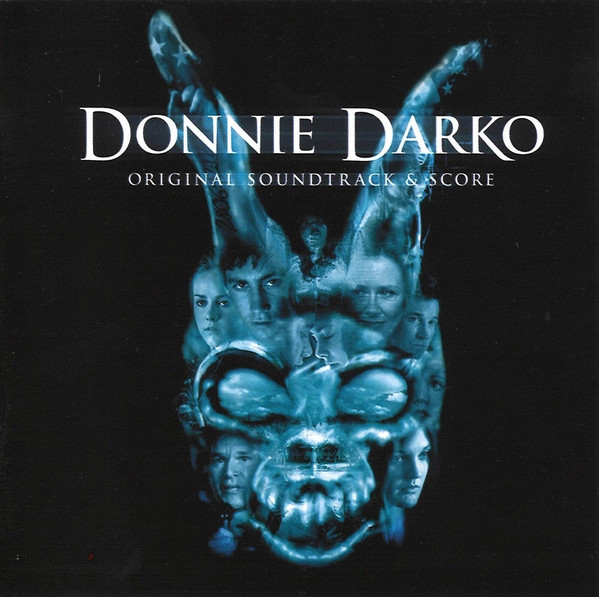
The Donnie Darko soundtrack is about as legendary as the movie itself, mainly because of the closing track (discussed later), but also because the menacing but romantic score seems to linger and meshes so well with the picture. California-based composer Michael Andrews wrote the score, and because of the limited budget, he played most of the instruments himself. The score’s tracks are in the order of their appearance in the film.
- “Carpathian Ridge” – 1:35
- “The Tangent Universe” – 1:50
- “The Artifact and Living” – 2:30
- “Middlesex Times” – 1:41
- “Manipulated Living” – 2:08
- “Philosophy of Time Travel” – 2:02
- “Liquid Spear Waltz” – 1:32
- “Gretchen Ross” – 0:51
- “Burn It to the Ground” – 1:58
- “Slipping Away” – 1:17
- “Rosie Darko” – 1:25
- “Cellar Door” – 1:03
- “Ensurance Trap” – 3:11
- “Waltz in the 4th Dimension” – 2:46
- “Time Travel” – 3:01
- “Did You Know Him?” – 1:46
The soundtrack also has several vibrant 1980s songs from the bands Joy Division, The Church, Echo & the Bunnymen, and Duran Duran. The opening song in the movie is “The Killing Moon” by Echo & the Bunnymen.
There was talk of U2’s “MLK” and the song “West End Girls” by Pet Shop Boys being in the soundtrack as well, but they never materialized. Fun fact: “West End Girls” was supposed to be the song used at the talent show for the Sparkle Motion performance.
‘Mad World’ Song
The most memorable part of the soundtrack is the song that plays at the end of Donnie Darko, a cover of Tears for Fears’ song “Mad World” with Michael Andrews on piano and Gary Jules on vocals. Lyrically, the song is an emotional journey of youthful angst, confusion, and gloom about being brought up in a crazy or “mad” world, with the melodramatic proposition that death is the only release from the madness. The song’s opening lyrics create a cadence through a simple rhyme schema:
All around me are familiar faces
Worn out places, worn out faces
Bright and early for their daily races
Going nowhere, going nowhere
Their tears are filling up their glasses
No expression, no expression
Hide my head, I want to drown my sorrow
No tomorrow, no tomorrow
Then comes the famous chorus:
And I find it kinda funny, I find it kinda sad
The dreams in which I’m dying are the best I’ve ever had
I find it hard to tell you, I find it hard to take
When people run in circles it’s a very very
Mad world, mad world
The lyrics were originally written by Tears for Fears’ Roland Orzabal in 1980 when he was only nineteen. Yet the Tears for Fears version is quite different than the Gary Jules rendition in Donnie Darko. The Tears for Fears version is catchy and almost uplifting (despite the sad lyrics), while the Gary Jules rendition in Donnie Darko is a morbid ballet. As one YouTube commenter points out on the Tears for Fears music video for the song, Tears for Fears focused on the song’s “kinda funny” part, and Gary Jules focused on the “kinda sad” part.
On deeper analysis, Orzabal likely wrote the song in a moment of teenage melodrama, but by the time it was processed through the band and the record label, it became a typical 80s pop song. What Gary Jules and Michael Andrews extracted in their rendition of “Mad World” was probably more akin to the sentiment Orzabal originally felt: one of hopelessness at the state of the world and utter melodramatic despair.
So why is the cover of “Mad World” so effective at the end of Donnie Darko? For one, the lyrics seem to match up so well with the visuals. As with all good sound design, the viewer almost thinks the song was written for the movie. The ending scene pans through all the “familiar faces” from the movie and shows them “drowned in sorrow” and as if there is “no tomorrow” — and the film collapses in on itself in a state of madness.
Frequently Asked Questions
Where does Donnie Darko take place? It takes place in a small rural town of Virginia called Middlesex; however, it was filmed in California and features no actual scenery from Virginia. Writer and director Richard Kelly grew up in Virginia and likely set scenes from his childhood in the movie. Kelly remarked that making the film in California was difficult, because they constantly had to hide palm trees from the cameras.
Is Donnie Darko a Halloween movie? Donnie Darko takes place in October, and the major events of the movie happen on Halloween night. The film’s distributor was confused about how to market it when it went to theaters, so when it had its short-lived theatrical release, Newmarket Films marketed it as something to see on Halloween. It’s not a traditional Halloween genre movie, though, despite the initial marketing. Donnie wears a skeleton suit for Halloween.

Is it a scary movie? Donnie Darko on first impression feels like a horror movie. It’s mainly driven by how ghostly and menacing Frank the Rabbit is. The film’s distributor wanted to make it more of a horror movie by making Frank the Rabbit murder children, but the director and creative staff refused to alter the movie that way. So yes, it’s a scary movie but not your typical horror flick.
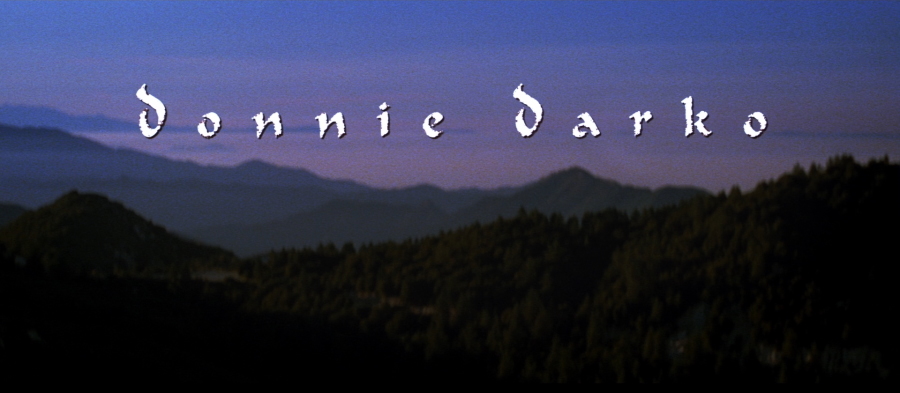
What is the Donnie Darko font or typeface? The fonts used throughout the film were all custom-made for the film. Reddit users have noted their similarity to the fonts Calligrapher and Flat Brush from the Broderbund collection. The Trajan typeface is also used. Another interesting fact about fonts in the movie is that after director Christopher Nolan saw the film, his only feedback was that they should update some of the typeface choices.

What role does schizophrenia play in the movie? Donnie seems to have mental illness. He sleepwalks. He hallucinates. He hears voices. However, after watching the film a few times, it becomes clear that Donnie is not crazy. We are told by Dr. Thurman that the pills he takes are “placebos. Just pills made out of water.” So Donnie’s visions and bizarre behavior aren’t a result of pills. Moreover, it’s clear that Frank is actually communicating with Donnie from another universe and what he is experiencing is real.
Why was the film controversial? Donnie Darko was primarily controversial because the first critics that saw the movie at Sundance were deeply divided. Some thought it was a terribly self-indulgent film, and others thought it was genius. It was also controversial because of 1999’s Columbine High School massacre. That was still a recent memory in 2001, and people were very uncomfortable with the scene where Donnie finds a pistol and shoots another high-school student. Last but certainly not least, September 11th happened, and then Donnie Darko came out in theaters a month later. This was made worse because the plot’s central premise is that a jet engine falls from the sky.
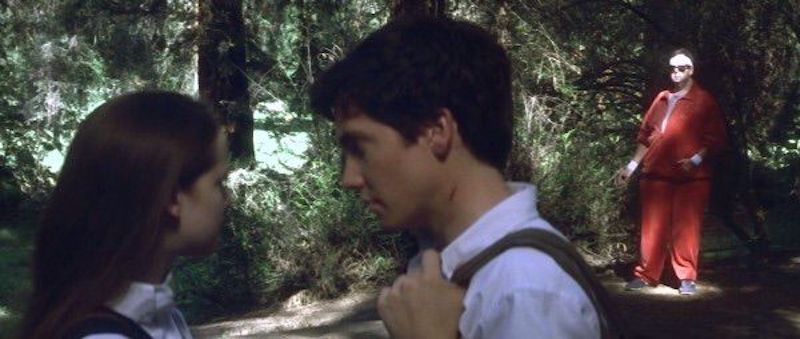
What’s the significance of the fat man in the red suit? In a movie full of strange things, the fat man smoking in the red jogging suit is particularly strange. Who is this guy? The director explains he’s an agent from the FAA (Federal Aviation Administration) sent to monitor the Darko family because of how strange the events are around the family and the plane crash.
Best Way To Watch/Stream
Although most people saw Donnie Darko at home on VHS or DVD, the director said the movie was made to be seen in the theaters. “I made this movie for the big screen, and so few people saw it in a theater when it first came out,” says Richard Kelly. He continues: “We need to keep the theatrical experience alive and bring people together in movie theaters.”
It’s unlikely you’ll see Donnie Darko in theaters now, but if you want to get as close to the theatrical experience as possible, perhaps don’t stream it on your phone via Netflix or Hulu. Watch it on the big screen. If you’re in the United Kingdom, there is 4K high-res Blu-ray available; in the United States, this Blu-ray edition is the highest quality you’ll get.
Whatever you do, don’t download a full movie torrent. Support the companies and artists that make these films come to life.
Sequel
There is no sequel to Donnie Darko. However, there is an unofficial sequel called S. Darko (2009) about Donnie’s sister Samantha. This is an unofficial sequel because the original writer and director of Donnie Darko, Richard Kelly, had no involvement whatsoever with the film and hasn’t even seen it. When Kelly was asked about the so-called sequel to Donnie Darko by Pop Matters, he said: “I had nothing to do with it. And I hate it when people try and blame me or hold me responsible for it because I had no [involvement]. I don’t control the underlying rights to the Donnie Darko franchise. I had to relinquish them when I was 24 years old. I hate when people ask me about that, because I’ve never seen it and I never will, so…don’t ask me about the sequel.” So if the director of the original doesn’t believe there is a sequel, you shouldn’t, either. Donnie Darko 2 is not a thing. Needless to say, Donnie Darko 3 is also not a thing.
